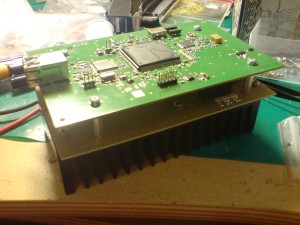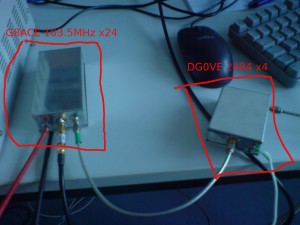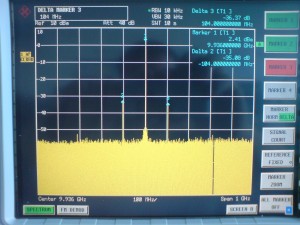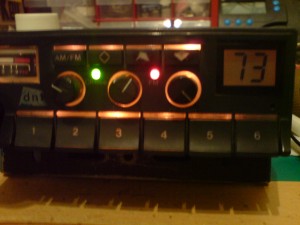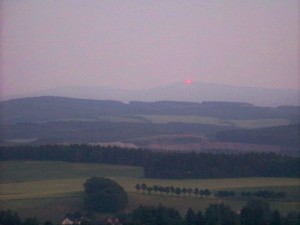Months ago i heard a talk of Andreas DL5CN about his software defined radio activities. He mentioned a hardware brought up by James N2ADR that works with his Linux SDR software QUISK. In the next both issues of the Funkamateur Guenter DL7LA and Detlef DL7IY described their experiences with the design.
The transceiver is a RF-to-bits design which means that the RF domain is samples with 122MSamples/s and bandfiltered, downconverted within an FPGA and transferred to the PC via an Ethernet interface. The transmit path is the other way around using a D/A converter. The details can be found in their article.
From them i got a commercial 2-layer PCB board with some improvements against the original layout from James. With the information i got from Guenter and Detlef and the info that can be found at James website i started purchasing the parts. It turned out that it is important to notice every piece of information very exact. In addition the power supply for the PCB is not part of the circuit (at least most of it). Therefore much effort needs to be spend to create a proper supply that also takes into account avoiding much noise in the supply for the analog parts of the circuit and avoid too much power dissipation in the regulators.
Last days i completed my power supply which now produces several voltages. 5V digital that supplies the regulators for 3.3V digital 2.5V digital for the FPGA. (An additional 1.2V regulator for the FPGA is located at the transceiver PCB and supplied by the 3.3V). At the analog side there are a 5V regulator for the RX preamp, 3.3V for the A/D, D/A converters and 7.5V for the MMIC TX amplifier. After some debugging i was able to load the FPGA configuration into the configuration flash. Today i was able to receive the first (self generated) signal with the receiver part.
Maximum RF bandwith can be between 25kHz and 500kHz.
There is still much todo. The circuit does still not contain any receiver preselection and no transmit amplifier except the few hundred mW that come out of the MMIC.
A funny thing was that nobody ever showed a picture of the bottom side of the PCB which is more or less a spiders web ;)
You can find further information and some more pictures at the Yahoo group i created for discussions. It can be found at
http://groups.yahoo.com/group/n2adr-sdr/
Multiplier Chain for 70cm -> 10GHz conversion
One of my long time projects is a transverter system for 10GHz build up with separate units.
A while ago i purchased a multiplier unit for 2.5GHz input x4. Nowadays i purchased also a kit for a x24 multiplier from G8ACE.
With the G8ACE multiplier i am able to get an output of around 13dBm at 2484MHz with 0dBm drive at 103.5MHz.
This signal is directly used to drive the DG0VE multiplier which gives around 23dBm at 9936MHz. I mounted an additional SAW filter that came from an wireless LAN application between the last multiplier stage and the stripline filter of the G8ACE multiplier. This reduces the spurious signals that are far away from the wanted signal.
As you can see at the screenshot at 9936MHz there are still some unwanted spurious signals that seem to be caused by mixing effects.
DM7A team in october UHF/SHF contest – a short video
Last week i collected all the video snippets i took during our contest activity in october 2010.
I used the Linux Opensource video software Openshot. Music comes from the band Phonotrash.
Have fun with the video…
Waldschloesschen Bridge
Output ripple on dm330mve
In my last post i described that my FT-817 is somehow sensitive to output ripple of switched power supplies.
My problems were caused when using it together with my Alinco DM330 30Amps supply.
So i tried to have a look to it with an digital oscilloscope.
It has to be said that this picture was taken without any load at the supplies output. My feeling is that these spikes are quite high with around 150mVpp. Within the FT-817 this seems not to be filtered much and causes spurious spectral lines with the distance of the supplies switching frequency.
Whe i opened the supply afterwards i somehow dissapointed. The soldering points are really bad and seem to almost disappear at some parts. This makes me doubt that all the parts are correctly soldered. Maybe thats the reason for the ripple. This has to be investigated. I will not use the supply until that is clear.
Also you have to be carefull with the 100V/230V input voltage range switch. Do NOT switch it to 100V for accident.
FT-817 synthesizer problems ?
Today i had a look to the output spectrum of my FT-817 i use for 23cm operations. I looked to the IF signal of 144MHz.
There are several spurs with a distance of around 28.5kHz of each other and <50dB of the wanted signal. This corresponds to my observation that strong neighbour stations can be heard in regular steps again and again. It happens in CW and also in SSB mode. Does anyone have a idea what could be the cause ?
I assume the problem is somewhere in the synthesizer...
Update 2010/10/01
When looking to older screenshots i saw that they were not that spurious. The difference was, that i did not use the switched power supply from Alinco at that time but a linear one. So i checked again with a linear supply today. Result: Most of the spurs disappeared. Just some weaker ones are remaining.
DUR test september 2010
Last weekend: Another times DUR activity. Another time from Triebenberg JO61XA. This time i used my new power generator. Unfortunately i missed some extra fuel and so i had to go qrt a bit earlier.
Highlight was a qso to DR3M north of Hamburg.
Etwas noch: Wenn man sich ueber die Signalqualitaet eines anderen OM beschwert, dann bitte qualifiziert. Denn nur dann kann man auch tatsaechlich etwas unternehmen. Ein “Scheiss Signal.” ohne weitere Information hilft vor Ort wirklich nicht weiter.
Recycling old CB radios
Some weeks ago i found an interesting webpage. At funkservice.at Gerhard offers PLL modules and DDS modules that fit to the LC7132 pinout of old CB radios. With these modules you can change your old 40 channel CB radio into an 80 channel version. I did this with my old dnt Carat exclusiv which was one of my very first radios that i ever owned. Now it has full 80 channels.
Unfortunately with this modification it lost its operating permission :)
But i am writing these lines because Gerhard also offers modules to modify old CB radios for FM usage within the 10m amateur band FM range. The modules will do automatic repeater shift within the 10m repeater frequencies.
This might be a good way to get some activity to this band using old CB rigs for doing some local qso on 10m in FM.
It is also a chance to support newcomers with transceivers that cost just a few Euro.
D-Star under impulse noise conditions
Last week DL3OCK generated a testfile for me. This file contains an FM signal and an D-Star signal with 50kHz offset. It can be transmitted with special equipment. I used this to check the behavior of my C5 70cm transceiver close to noise level and with impulsive noise. Find the videos below.
http://www.youtube.com/v/0Zz1Qd5ch4A
This video shows the comparison between D-Star and FM at around -115dBm.
It is clearly audible that D-Star has some advantages against FM if the decoder can stay in sync. The microphone of the camera does not represent the FM very well. In reality the FM sound was slightly better.
http://www.youtube.com/v/0mD1gWB2B58
This video shows the performance of FM vs D-Star under impulsive noise conditions. It is clearly audible that D-Star works without problems when FM is hard to understand.
DM7A team July Contest 2010 in JO60LK / 38km laser contact
last weekend i participated in the V/U/SHF contest within the DM7A contest group. We were qrv from JO60LK (mountain Fichtelberg). This time Murphy was definitively with us. Problems with the mains supply, defect power supplies, missing rotary controller, defect 23cm rig, no chance to get german UMTS network… Not even the german DVB-T network could be received from our location at the Small Fichtelberg. We had to view the soccer game DL-LU in OK TV ;)
Find some pictures here:
http://dh5ym.hopto.org/DM7A/DM7A_Jul10/thumb.html
In the evening we tried Laser from Fichtelberg to the Dittersdorfer Hoehe near Chemnitz. The laser light from DK5WMA was visible immediately after switching on. The opposite direction worked as well after adjusting the direction on my side.
The signal was really strong but with heavy fast QSB due to the very humid air. We did the contact in CW. Find below a picture and a short video of my CQ loop that were taken by Marcel.
http://www.youtube.com/v/Au8nCtY_mjk
The following video shows how the laser of DK5WMA was seen in JO60LK. Of course the light was much brighter. The camera sensor seems not to take the green light very well. The flickering has its origin in the high air humidy and moving air because of some wind. The light was sent with constant amplitude at this moment.

